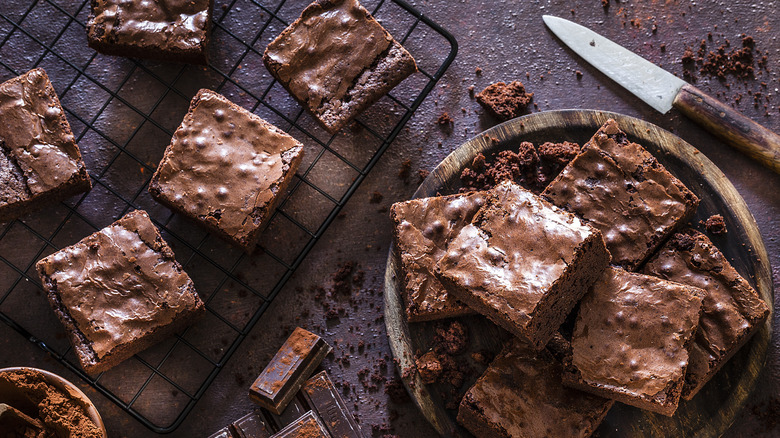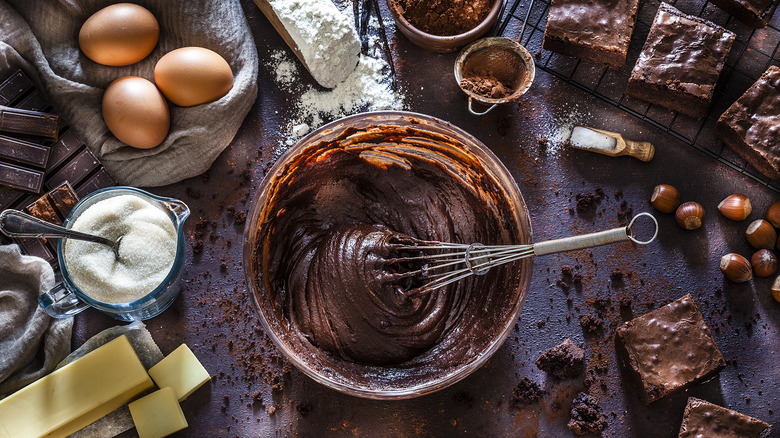The Crucial Tip For Baking Brownies At A High Altitude
Seasoned bakers know that baking is an exact science. You can't really fudge the amount of your ingredients too much or you can end up with a total disaster. Something as simple as a recipe for brownies needs to be measured to the gram, preferably using a kitchen scale. But one of the less obvious components of baking is altitude, and how higher altitude can affect your baking. If you're planning on baking brownies in the Alps (and why not?), there's one important thing to consider — the lower air pressure and low-moisture atmosphere can change your brownies' whole game. This means you'll have to adjust your brownie recipe in order for it to work at high altitude.
When baking brownies thousands of feet above sea level, you need to know that many of the ingredients, as well as your bake time, will have to be decreased. Conversely, you'll need to increase baking temperature and the portion of some ingredients — mainly wet ingredients for moisture. The long and the short is that baking is a precise science and a delicate art, and the outcome of your bake can be affected in complex ways by a simple change in air pressure.
Why altitude matters in baking
What does altitude do to baking exactly? Higher altitude changes the density of air and the higher up you are, the less dense the air around you is. So why and how does this affect baking? It decreases air pressure, which in turn causes moisture to be lost more quickly and can also cause batters to rise faster and more profoundly. A clear difference is that water boils at a lower temperature at higher altitudes. At sea level, the boiling point for water is 212 degrees Fahrenheit, whereas if you're boiling water in Denver for instance, boiling will occur at 202 degrees Fahrenheit.
At high altitudes, you can increase normal brownie-baking temperature by about 20 degrees Fahrenheit, and decrease bake time by about 6 to 8 minutes. Increasing temperature will help your brownies reach doneness faster. This way they avoid collapsing or dryness due to quicker moisture dissipation.
Additionally, to make up for the lost moisture in your brownies while baking in the Rockies you can add more liquid, roughly 1 to 2 tablespoons extra for a standard brownie recipe. Rather than using milk or water, consider adding moisture to brownies with sour cream, which has a higher viscosity than water and will slow evaporation — and result in a luscious fudgy texture. Sour cream can be substituted one-to-one for milk or water in any recipe. In fact, you can use this handy baking tip generally speaking, despite your elevation.
More brownie adjustments for high altitude
Bakes will rise more easily with less air pressure simply because the atmosphere is drier — and with higher altitude, there is less strain on your brownies' ability to rise. Many brownie recipes skip the leavening agents altogether, and when you're baking high up you can rely on eggs alone to rise your brownies, as minimal lift is needed for the structure of this treat. It's best to do test runs of your bakes when in different altitudes to see what works for you, but you can get some serious air sans baking soda and/or powder.
Sugar might also need to be reduced, as it can become concentrated during baking due to the increased dissipation of moisture. High-altitude brownies made with lower amounts of sugar will not only taste just as sweet, they'll set correctly once they're out of the oven. Try reducing your mountain vacation brownie sugar content by 1 to 3 tablespoons per cup of sugar the recipe calls for. There will be trial and error when baking at higher elevations, and the higher the elevation, the more adjustments you'll need to make. Start with these tips and tricks, and troubleshoot based on how and why they work.


